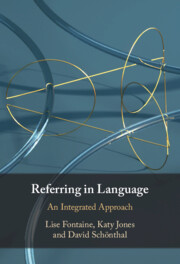Book contents
- Referring in Language
- Referring in Language
- Copyright page
- Contents
- Figures
- Tables
- Acknowledgements
- Part I The Nature of Referring and Referring Expressions
- 1 The Multidisciplinary Field of Referring
- 2 The Great Debate
- 3 A Functional Grammar for Referring Expressions
- Part II Typical Reference
- Part III Atypical Reference
- References
- Index
3 - A Functional Grammar for Referring Expressions
from Part I - The Nature of Referring and Referring Expressions
Published online by Cambridge University Press: 22 June 2023
- Referring in Language
- Referring in Language
- Copyright page
- Contents
- Figures
- Tables
- Acknowledgements
- Part I The Nature of Referring and Referring Expressions
- 1 The Multidisciplinary Field of Referring
- 2 The Great Debate
- 3 A Functional Grammar for Referring Expressions
- Part II Typical Reference
- Part III Atypical Reference
- References
- Index
Summary
This chapter provides a cognitive-functional description of the lexicogrammar of referring expressions and explains the grammatical realisation of referring, including the functional elements of the noun phrase and the structures that serve to realise them. Perspectives from cognitive grammar are prioritised, since referring expressions are first and foremost cognitive in nature. Given that they are also designed to serve a social purpose, the grammatical description presented in this chapter draws on various functional frameworks to reflect how its use also meets the needs of the addressee. This chapter serves as a basis for the linguistic terms relevant to lexical referring expressions, thereby providing a vocabulary for talking about various aspects of these expressions.
Information
- Type
- Chapter
- Information
- Referring in LanguageAn Integrated Approach, pp. 48 - 70Publisher: Cambridge University PressPrint publication year: 2023
